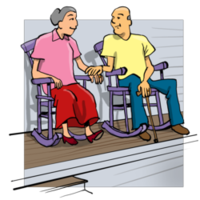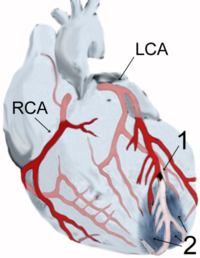Deep Voices, Sexual Attraction and Children

I know that there are going to be a ton of exceptions, but I was extremely interested to see a study in the journal Biology Letters that seems to indicate that a deep male voice may attract women more than a great physique or an attractive face. Men with deep voices are also much more likely to have more children than men who do not have deep voices.
The investigators used an interesting analogy, sating that a man’s deep voice is a bit like a peacock’s tail: it has no survival value, but attracts the female of the species. Testosterone masculinizes the voice at puberty.
The research team interviewed 52 women and 49 men aged 18-55, from the Swahili–speaking Hadza tribe in Tanzania. They chose the Hadza tribe because their lifestyles reflect those of our hunter-gatherer ancestors. The females gather berries and search for wild plants. The males collect honey and hunt animals. Even though the Hadza are monogamous, extra-marital sex is common, but there is no birth control.
During the interviews, which took place in Swahili, the voices of the men and women were recorded. On studying the recording later they found that the deep voiced men had fathered more children than the non-deep voiced men. The man with the deepest voice had ten surviving children, while the one with the highest pitched voice had three.
Coren Apicella, the lead author, suggested that perhaps the males with the lower pitched voices had higher testosterone levels, which attracted them more to females or made them more attractive to them. It is also possible that men with higher testosterone levels start reproducing earlier in life. They may also be better hunters, since testosterone may have an impact on muscle mass, and a better hunter would bring more food, allowing their wives to have shorter inter-birth intervals.
It is possible that if vocal dimorphism evolved partly due to mate selection, then in the past men and women may have had more similar voices.
I don’t suppose that anyone is going to be too interested to hear this, but your humble reporter has always had a very deep voice…
Molecules of Loneliness

It is well known that our social environment has a major impact on our health, wellness and longevity. Lonely, socially isolated adults have a higher mortality than those who are socially engaged.
There has been a lot of speculation about the factors involved, and there is a fascinating study published in the current issue of the journal Genome Biology.
Researchers from UCLA identified a distinct pattern of gene expression in the white blood cells of people who experience chronically high levels of loneliness. The findings suggest that feelings of social isolation are linked to alterations in the activity of some of the genes that drive inflammation providing a molecular framework for understanding why social factors are linked to an increased risk of heart disease, viral infections and cancer.
Lonely people suffer from higher mortality than people who are not, and the debate has been whether that risk is a result of reduced social resources, or whether it is biological.
In this study the researchers used DNA microarrays to survey the activity of all known human genes in white blood cells from 14 individuals in the Chicago Health, Aging, and Social Relations Study. Six participants scored in the top 15% of the UCLA Loneliness Scale, a widely used measure of loneliness that was developed in the 1970s; the others scored in the bottom 15%. The researchers found 209 gene transcripts that were differentially expressed between the two groups, with 78 being over-expressed and 131 under-expressed. Genes over-expressed in lonely individuals included many involved in immune system activation and inflammation. At the same time, several other key gene sets were under-expressed, including those involved in antiviral responses and antibody production.

The first author on the study s Steve Cole, an associate professor of medicine in the division of Hematology-Oncology at the David Geffen School of Medicine, and a member of the UCLA Cousins Center for Psychoneuroimmunology, and he had this to say:
“What this study shows is that the biological impact of social isolation reaches down into some of our most basic internal processes the activity of our genes.
We found that changes in immune cell gene expression were specifically linked to the subjective experience of social distance. The differences we observed were independent of other known risk factors, such as health status, age, weight, and medication use. The changes were even independent of the objective size of a person’s social network.”“We found that what counts at the level of gene expression is not how many people you know, it’s how many you feel really close to over time.”
This study was supported by the National Institutes of Health, the Mind, Body, Brain and Health Initiative of the John D and Catherine T MacArthur Foundation, the Norman Cousins Center at UCLA, the John Templeton Foundation, and the James B Pendelton Charitable Trust.
Although small, this is remarkable and shows how much nature not only abhors a vacuum, but also dislikes isolation. We are social animals and anything that gets in the way of that will likely lead to a very poor outcome.
It is fitting that Norman Cousins, for whom the UCLA center is named, had this to say:
“The eternal quest of the individual human being is to shatter his loneliness.”
“The most terrible poverty is loneliness and the feeling of being unloved.”
-Mother Teresa of Calcutta (Albanian-born Indian Nun, Humanitarian and, in 1979, Winner of the Nobel Peace Prize, 1910-1997)
A Shocking Study

I have been teaching medical students and doctors since the 1970s. But there have recently been times when I have despaired about the way in which so many young doctors no longer engage in common courtesies with their patients.
I just spoke to someone who had visited a new family physician. She was fresh out of her residency, and her residency director has something to answer for. She did not make eye contact or shake hands, and could not remember the person’s name. When the patient extended her hand the doctor became confused because she was focused on her laptop.
I know that I can be accused of being old fashioned, but that shocked me, as did a recent report that medical students at a highly rated school are going to be getting classes in empathy and talking to people. This was announced with great fanfare. My question: why on earth do intelligent people need to be taught how to communicate? And if they have a problem in that area, first, how did they get accepted into that excellent medical school? During the years that I was involved in medical school admissions, I would have not have given a high score to someone with poor interpersonal skills. Second, why are the students’ teachers not modeling communication skills?
So first I heard about the extraordinary manner of the primary care physician. Then it was the self-congratulation that accompanied the announcement that students were going to be taught how to speak to people.
And then this.
A study in the Archives of Internal Medicine that left me shaking my head.
The researchers from Northwestern University’s Feinberg School of Medicine found that Doctors do not address patients by name in half of first-time visits, even though nearly all patients want this common courtesy.
There has been research on what doctors should wear but little about how they should greet patients or what patients actually expect. Most good physicians have relied upon empathy and common sense to guide them. This study focused on finding out what patients think is an appropriate greeting. He also analyzed a sample of interactions between doctors and patients during first-time visits.
The researchers collected information from 415 phone surveys in which people were asked how they expect to be greeted by a doctor. Researchers also viewed and analyzed more than 120 videos of primary care visits in which the doctor and patient met for the first time.
They found that 78 percent of survey respondents wanted the physician to shake their hands. Nearly all patients wanted to be greeted by name, including 50 percent by their first name, 17 percent by their last name and 24 percent by both their first and last name. Most patients, about 56 percent, wanted physicians to introduce themselves using first and last names, while 33 percent expected last name and 7 percent expected first name.
The researchers found a striking difference between expectations voiced in the phone surveys and the actual interaction between doctors and patients in the videos. While 83 percent of doctors shook hands in the videos, only half addressed the patient by name.
Obviously everyone has their own communication style, but the researchers recommend that doctors should incorporate a greeting strategy that uses first and last names for both doctor and patient. Doctors also should plan to shake a patient’s hand, but need to be sensitive to body language or other nonverbal cues that may indicate whether a patient does not want to or is not physically able to reciprocate or respond.
How we use names or handshakes will also change over time.
Why does this business of doctor-patient communication matter so much?
It is not simply a point of courtesy, though that would not go amiss. The real issue is that relationships are the heart of healing. Relationships might not be so important to the person performing some technical service, but for healing they are essential. If I need to get my car fixed, it is nice if the mechanic wants to talk, but it is not essential. He can treat my car as the hunk of metal and moving parts that it is.
But healing is different from treatment. Healing demands a relationship, intention and a shared vision. An interaction that will create something that is greater than the sum of the parts. A polite, personal greeting creates a first impression that can affect the chance of developing a therapeutic relationship. Ignoring the normal rules of social interaction sets the tone for everything that comes afterwards. It is respectful to use a person’s name and on a purely practical level, helps ensure that you are seeing the right person! More than once I have been given the wrong chart before meeting a person for the first time.
Interestingly, accrediting organization quite rightly emphasize that communication is a critical skill for physicians. Sadly many medical schools put such a huge emphasis on academic attainments that some people enter the medical profession without natural communication skills, and their training does little to help them get better at it. But this skill may not come naturally to all doctors, so it’s important to offer guidance on different aspects of communication such as greetings
My students will tell you something that I have said a thousand times: “You have spent a lifetime developing people skills. You have learned how to talk to Aunt Mabel, how to feel when you are in a dangerous environment and how to deal with that guy at the bar who is becoming annoying. These are very valuable skills. Why did you check them at the door on the day that you entered medical school?”
One of my mentors once lamented, saying that 90% of medical students would have been better served by a technical college than a medical school, because they had no curiosity, no desire to move the field forward and no wish to engage with the people who came to see them. And that was in England, where there is socialized medicine. I did not want him to be right, but he probably was. In fact he was right about a great many things, which is why he was nominated for the Nobel Prize in Medicine on three occasions.
If medical schools want to turn out healers rather than technicians, then it is clear that medical students and doctors have to be helped to learn basic communication skills.
One of the many reasons that so many holistic therapists and practitioners of Integrated Medicine are popular is that they do understand the importance of good communication. Not because of research, but because that is their natural way of being.
What have your interactions with doctors been like?
How do you like them to greet you?
“True communication is remembering that everything is relationship — that, regardless of the appearance, no one stands alone.”
–Hugh Prather (American Spiritually-oriented Counselor and Writer in the Field of Personal Growth and Relationships)
“Once a human being has arrived on this earth, communication is the largest single factor determining what kinds of relationships he makes with others and what happens to him in the world about him.”
–Virginia Satir (American Family Therapist, 1916-1988)
Personal Mastery and the Wellness of Caregivers

Looking after aging relatives can be incredibly difficult, particularly if they have a chronic illness such as Alzheimer’s disease.
There is also evidence that the caregivers of people with Alzheimer’s disease have increased rates of cardiovascular disease and they die prematurely. It has been assumed that the cardiovascular problems are a result of stress causing overdrive of the sympathetic nervous system.
There was some interesting research (NR241) presented last month at the 2007 Annual Meeting of the American Psychiatric Association in San Diego. The investigators did not have to come far: they are from the University of California in San Diego.
The investigators looked at 70 spousal caregivers of people with Alzheimer’s disease and used an experimental task to measure the activity of their sympathetic nervous systems. They also measured the caregiver’s levels of “Mastery:” the belief that one is capable of handing one’s problems. Mastery is one of the components of resilience, a key characteristic of a person who can handle stress well.
What they found make very good sense: the caregivers with the highest levels of personal mastery had the lowest levels of sympathetic activity, suggesting that a sense of mastery may protect against the physiological effects of acute stress.
This provides us with yet more evidence that psychosocial interventions that increase mastery may reduce the risk of cardiovascular disease amongst the caregivers of people with dementia.
Successful Aging

One of the most promising changes in psychology is the ever-greater emphasis on what makes us healthy, rather than constantly looking at the things that make us sick. There is an important approach called Behavioral Activation (BA) Theory, which emphasizes environmental and behavioral factors as determinants of our overall well-being. According to the theory, reduced engagement in pleasurable activities may be an important precursor of reduced well-being. This makes good sense: it is estimated that as much as 90% of our higher cortical functions are designed for social interactions.
This is something that I wrote in Healing, Meaning and Purpose:
“Nothing in the Universe exists in isolation: We live in a Universe of relationships. It is inconceivable that anything can exist except in relationship to something else. The entire Universe is made up of integrated systems that function, develop and evolve together. A failure to construct and maintain healthy relationships can be a cause of much distress.
Several years ago I reported some interesting observations. At the time, I was doing a lot of research on diseases of blood vessels. I had developed a laboratory method for taking some of the cells that line blood vessels from volunteers and then growing them in a cell culture dish. We discovered that if we did not have enough cells in the dish, they would all die of “loneliness.” The exception is cancer cells, which in culture will grow on their own, like weeds.”
As an example in a paper published in February in the Archives of General Psychiatry it was shown that lonely individuals may be twice as likely to develop the type of dementia linked to Alzheimer’s disease in late life as those who are not lonely. The theory has been shown to predict psychiatric well-being in a number of populations, including the caregivers of people with Alzheimer’s disease, people with chronic pain, cancer patients and community-dwelling older people.
It is also known that psychiatric well-being, particularly emotional well-being, may play an important role in cardiovascular health. This may be due to an increase in the activity of the sympathetic nervous system that increases not only blood pressure, but also the levels of inflammatory mediators and coagulant factors in the blood.
In research from the University of California at La Jolla that was presented on Monday at the 2007 Annual Meeting of the American Psychiatric Association in San Diego, California, twenty two people with a mean age of 70 were studied, to see if there was a link between their behavioral activation, i.e. how satisfied they were with their leisure activities, their affective well-being and their blood pressure.
The findings were as expected: the less satisfied and engaged people were, the higher was their blood pressure.
This is only preliminary data, but it confirms something that we have said before: as we get older it is as important to stay socially engaged as it is to do mental exercise.
And if you known someone who is older and isolated, you might want to go and see them.
“The most terrible poverty is loneliness and the feeling of being unloved.”
–Mother Teresa of Calcutta (Albanian-born Indian Nun, Humanitarian and, in 1979, Winner of the Nobel Peace Prize, 1910-1997)
“What makes loneliness an anguish is not that I have no one to share my burden, but this: I have only my own burden to bear.”
–Dag Hammarskjöld (Swedish Statesman, Secretary-General of the United Nations from 1953-1961, and, in 1961, Winner of the Nobel Peace Prize, 1905-1961)
Attachment and Well-Being In the Elderly

Attachment theory is a psychological concept that was developed by John Bowlby in Britain and Harry Harlow
in the United States in the late 1950s. The idea is that humans and
many other animals have evolved an adaptive tendency to maintain
proximity to an attachment figure.
Attachment is defined as an emotional bond that one person forms
between himself or herself and another specific person. Originally the
theory was developed to explain the relationship of a parent and child,
but over tie it has become realized that attachments can occur
throughout life, and if they become abnormal, they can lead to
loneliness, isolation and psychopathology. There has recently been a resurgence of interest in attachment styles, and how they interact with emotional and behavioral expression during the development of dementia.
There was some interesting research presented today at the 2007 Annual Meeting of the American Psychiatric Association
in San Diego, California. Investigators from Charlottesville, Virginia
looked at 39 older patients (27 were women): 49% were aged between 65
and 74 and the remainder was over 74.
- 41% of women and 33% of the men said that their activities were limited by physical and/or emotional problems
- 41% of the women and 17% of the men endorsed at least two out of three indicators of depression
- When they examined their attachment styles, 28% were secure, 59% avoidant and 13% enmeshed
- An avoidant attachment pattern is more common among the elderly than it is among younger people
- Understanding attachment style could be very helpful in
understanding how people react to their healthcare providers and their
preferred coping styles
For anyone working or living with elderly people, attachment theory
is well worth investigating. There is already some preliminary evidence
that specific interventions may help older people with avoidant
attachments.
A Pill for Every Ill?

Many of us have been becoming more and more worried by the idea that if we don’t like something, then we should take a pill, rather than trying to get to grips with the causes.
Can’t sleep? Take this pill. {Ahem, but why not try sleep hygiene first?)
Shy? No, you’re not allowed to be shy, you have social phobia, take this medicine.
Don’t like the size of your tummy? Don’t exercise; we have just the pill for you!
Not only does this approach undermine our responsibility and autonomy, it also minimizes the suffering of people with real clinical problems. When every headache gets labeled a “migraine” and every cold gets turned into “’flu,” it is easy to lose patience, empathy and understanding for people who are really suffering with the genuine article.
Here is a fine example of an announcement that has doubtless caught the attention of headline writers around the world. Researchers from the Medical Research Council’s Human Reproduction Unit in Edinburgh in Scotland are reported to be working on a pill that would simultaneously boost a woman’s libido while at the same time reducing her appetite for food.
So what is this all about? Professor Robert Millar leads the Edinburgh team that has been looking at the properties type 2 gonadotropin-releasing hormone (GnRH), one of the hormones responsible for the release of sex hormones.
When it was given to monkeys, they displayed mating behavior such as tongue-flicking and eyebrow-raising to the males. When it was given female musk shrews, they displayed their feelings via “rump presentation and tail wagging.” These are two interesting visual images.
The thing is this. The tongue-flicking, eyebrow-raising tail wagers also ate around a third less food than they normally would. So now the search is on to find a pharmaceutical company that would like to make some kind of GnRH pill that would, presumably, produce libidinous skinny women.
Not only is this a frightful type of reductionism, but it raises all kinds of ethical issues.
The researchers in Edinburgh have been turning out a substantial body of very respectable data over the years, and this story looks very much like something that has been embellished.
Few people believe that eating or human sexuality are reducible to single chemicals in the brain. Low libido is a common problem, but it is usually a sign of stress, fatigue or relationship problems, rather than a chemical imbalance in the brain. And what, when and how we eat is an extraordinarily complex issue that is as much psychological and social as it is chemical. Stimulating the libido of someone in a lousy relationship is unlikely to lead to peace and harmony.
The whole concept also returns to the question of “what is normal?” when it comes to food, size or sex.
Heart Attacks, Meaning and Relationships

I am a doctor who has spent my career trying to empower people to take control of their lives, to fulfill and exceed their potential and to achieve and maintain vibrant good health. So I have worked my backside off to help people to deal with disease. But the curing of maladies is only half of our task. We also need to learn why things go wrong and what they are trying to teach us. So many of us have become wedded to the idea that illnesses are nuisances to be conquered rather than inevitable parts of life that can help us to grow and develop.
If our search just keeps turning up negatives, “I keep getting sick because I have bad luck/was born under a bad sign/have bad karma,” then you may need a little help from a therapist to help with those negative cognitions.
Here is a remarkably interesting study published in the current issue of the Journal of Advanced Nursing, that buttresses years of my own clinical observations: A third of people who suffer myocardial infarctions (heart attacks) discover new meaning to their lives and reconnect with their partner, but others see it as a threat to their well-ordered existence.
Researchers from Switzerland and the United States explored the experiences of 24 couples to see whether the one of them having had a heart attack changed their lives and their relationships. According to the researchers, three distinct behavioral patterns emerged as people tried to cope with a person’s heart attack:
Some said that the heart attack was an important and necessary event which had brought them closer together and transformed their lives.
Others felt fearful and threatened by the fact that they had no control over an unpredictable future.
The last group looked at various possibilities for positive change as a result of the heart attack. But they did not achieve them and felt that they had missed their chance to make things better.
It would be easy to pass off the people in the first group with the positive responses as “rationalizers:” people who are trying to make the best of a bad situation. But that would be a mistake. Severe, particularly life-threatening illness can often have a transformative effect on people an those around them. The key is to provide them with positive psychological and spiritual support.
This research strongly reaffirms the principle that successful recovery from a serious illness means more than eradicating it. It really means dealing not just with the physical, but also the psychological, social, subtle and spiritual aspects of what has happened.
In a cardiac rehabilitation program, if a person is in a stable relationship, it is essential to involve both partners in the program so that support can be tailored to their own individual relationship.
The lead researcher was Dr Romy Mahrer-Imhof, from the Institute of Nursing at the University of Basel in Switzerland, and she had this to say, “For example, counseling could provide these couples with more choices about how to negotiate more intimacy in a relationship in which each partner’s needs and wants are respected…. Group session are also useful as they show people how other couples deal with similar situations, helping them to conquer fear and find new ways of living, despite the illness.”
One of the reasons that I’m so militant about aggressive rehabilitation and involving the family is this. As a very young freshly minted doctor, I was involved in the care of a man who suffered from a very small heart attack at the unusually early age of 28. He made an uneventful physical recovery, but announced to his family that he would never work again, and that sexual intimacy or any other kind of physical activity was now out of the question for him. Overnight, he had become a needless cardiac cripple. As he left the hospital he refused to get dressed in regular clothes, but instead wore pajamas and a bathrobe. He shuffled along like an old man despite the fact that his exercise tolerance was probably as good as mine. He refused all offers of help, would not go to rehabilitation and refused to see a psychologist or counselor. Despite the fact that his heart had recovered completely, he died within a year.
Nobody could have forced him into having treatment, and as a newly qualified doctor I was only the team tadpole.
But if I’d known then what I know now, I doubt that he would have had such a sad outcome.
Enabling the re-integration of the whole person – body, mind, spirit, subtle systems and relationships – is the central core of Integrated Medicine and Healing, Meaning and Purpose.
“No man is an Island, entire of it self; every man is a piece of the Continent, a part of the main; if a clod be washed away by the sea, Europe is the less, as well as if a promontory were, as well as if a manor of thy friends or of thine own were; any man’s death diminishes me, because I am involved in Mankind; And therefore never send to know for whom the bell tolls; It tolls for thee.”
–John Donne (English Metaphysical Poet and Divine, 1572-1631)
“Deep within himself man seeks meaning for his life, and tries to fulfill himself in accordance with that meaning.”
–Viktor Frankl (Austrian Psychiatrist and Holocaust Survivor, 1905-1997)
“When we are motivated by goals that have deep meaning, by dreams that need completion, by pure love that needs expressing, then we truly live.”
–Greg Anderson (American Author and Founder of the Cancer Conquerors Foundation, 1947-)
“Love is the ultimate meaning of everything around us”
— Rabindranath Tagore (Indian Poet, Playwright, Essayist, Painter and, in 1913, Winner of the Nobel Prize for Literature, 1861-1941)
Women and the “Over-Attractive” Male
Here’s another one of those pieces of research that leave you thinking, “Didn’t I already know that?”
Researchers at the University of Central Lancashire in England have found that men who are good-looking, single and earn a large income are not as attractive as good-looking men with an average job and income. It may be important that the research was done in England: social status is still far more heavily engrained in society than it is in the United States or Australia.
The research was published in the journal Personality and Individual Differences, and examined how 186 heterosexual female students weighed up the male physical attractiveness and socioeconomic status when considering a long-term relationship. The average age of the test subjects was 23, and they were asked to look at personal ads of a number of men and to rank them in terms of attractiveness as a long-term partner. Each advertisement showed a photograph and provided basic information about the man’s age, occupation and what he was seeking in a partner.
The images of the men had previously been measured on a subjective scale of attractiveness. The men were randomly allocated to eighteen different occupations that varied from an architect and company director to a waiter, postman and gardener.
The researchers found that men who were rated as physically highly attractive but had medium social status, scored better than highly attractive men of high status. The authors speculated that the highly attractive high status men might have been thought to be more likely to be unfaithful in relationships or to be “too good to be true.” I was reminded here of a piece that I wrote in November: many people probably make mistakes in evaluating the potential of relationships simple because they under-estimate themselves.
Not only would it be good to repeat this research outside England, but it would also be a good idea to do similar experiments with women and people with different sexual orientations. There is some research that men at that age tend to make more superficial evaluations about potential partners.
The take home message: don’t try to make yourself look better than you are, it may backfire; don’t under-estimate yourself and look below the surface when making any important decision.
And Fabio, eat your heart out!
“Men in general judge more by the sense of sight than by the sense of touch, because everyone can see, but only a few can test by feeling. Everyone sees what you seem to be, few know what you really are, and those few do not dare take a stand against the general opinion.”
–Niccoló Machiavelli (Italian Writer and Philosopher, 1469-1527)
“Judgment and love are opposites. From one comes all the sorrows of the world. From the other comes the peace of God. Judgment will bind my eyes and make me blind.”
–A Course in Miracles (Book of Spiritual Principles Scribed by Dr. Helen Schucman between 1965 and 1975, and First Published in 1976)
Arthritis and Sex
Today being Valentine’s Day (you did remember didn’t you?), Arthritis Care in the United Kingdom has taken the opportunity to publicize its free booklet on sex, relationships, intimacy and arthritis, downloadable from its website (pdf).
Integrated Medicine is all about empowering and caring for the whole person, so I was very pleased to see this document. I spent some very happy times helping people with various types of arthritis, and I was astonished how infrequently anyone had ever asked them about the ways in which the illness impacted normal daily activities and had ever given them any advice on ways to work around problems.
Let me quote form the Arthritis Care news release:
"One of the reasons we produced the guide is to address issues people felt awkward discussing. It may be embarrassing to talk to your consultant rheumatologist, nurse or GP about emotional and sexual things, or matters of self-image and self-esteem – and they may be embarrassed to be asked. So where do you turn?’ said Kate Llewelyn head of publications at Arthritis Care, who was diagnosed with rheumatoid arthritis at the age of thirteen.
The booklet provides a valuable insight for healthcare professionals and for the partners and families of people with arthritis, highlighting issues of concern to them, and suggesting practical and achievable solutions.
For people with arthritis, or other disabilities, difficulty can start before any relationship, pre-dating any date.
‘Managing pain and other symptoms is exhausting, and it stops many people getting out and socializing. As a result, arthritis can be isolating, keeping you from making friends or seeing family, let alone dating and finding a partner. And maybe you are not very mobile, so can’t dance, or play sport, or can’t drink because of your medications. What’s more, although anti-discrimination law means venues must now offer better access for disabled people, you still may find it harder to do things people without arthritis take for granted’, said Kate Llewelyn.
Once a relationship has been formed, the challenges continue; the couple must work out ways of ensuring their personal and sexual relationship is sustained and developed, overcoming and working round the incurable and debilitating condition.
The report discusses a number of very practical matters: how pain and also medication can interfere with sex drive and some can cause weight gain. Many forms of arthritis are also associated with anemia and/or chronic fatigue.
It also discusses some of the psychological factors that can interfere with the sex lives of arthritis sufferers. For example, men may feel emasculated if they cannot perform their ‘traditional’ roles like playing sport or carrying heavy objects. Women may feel unfeminine if they put on weight with steroids, cannot do the housework or lift their children as a result of having arthritis. Others, with limited joint movement, or severe pain may be put off sex altogether, or find some of the traditional sex positions too uncomfortable.
‘The book has got diagrams of lovemaking positions which people of differing physical abilities and limited movement have found useful. If you’ve got problems with your spine, or hips, or knees, it makes sense to experiment with positions that place least weight or strain on the rogue joints. Of course, after joint surgery or replacement, you may be advised to take a temporary break from sex, but, relationships are more than sex, and, with this guide, abstinence may make the heart grow fonder’, said Kate Llewelyn.
Sex is rarely discussed with people strugglig with chronic illness, often because health care providers get embarassed about it.
It is essential for that to change, and I want to say a big thank you to Arthitis Care for having the courage to do this.






